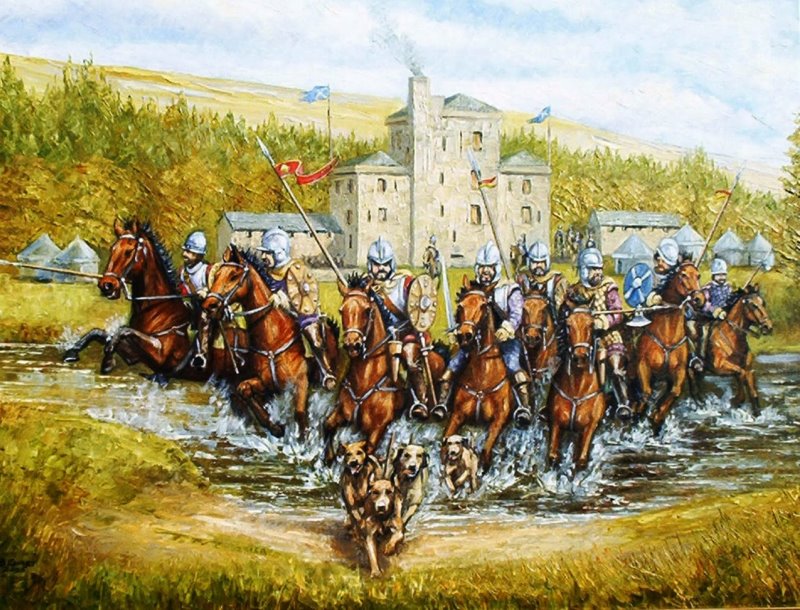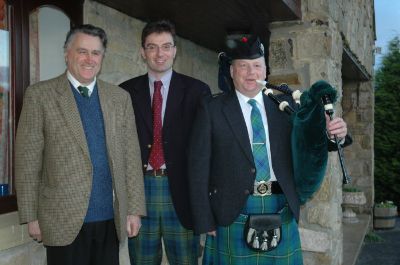Johnston Clan History
from Past to Present
Written and Contributed by Janet J. Johnston
The heritage of Dr. Lancelot and his brother, David Johnston traces back to Annandale, Scotland. According to written documentation, one of which
was written by Dr. William Johnston, Dr. Lancelot’s son,
in an 1849 letter, a James Johnston was killed in a
battle in Scotland and his wife, Jennie MacDonald, the daughter of the Laird of Glencoe, feared that the same fate could befall her only son, John.
She sold the Johnston land in Annandale, Scotland and migrated to Ireland in 1602/1603 where she bought land in both County Fermanagh and County
Tyrone. Her son, John was known as “Old Lurg”. Lurg is a Barony in County Fermanagh where Dr. Lancelot and David Johnston were born. They were
direct descendants of “Old Lurg” John Johnston.
FROM PAST
In ancient Scotland, the first people to acquire surnames were Norman nobles who came from France. Many came with William the Conqueror. In
the twelfth century, there was a man named John. This John was given lands by a Norman lord, Robert the Bruce, the 1st Lord of Annandale, who in
1124 had received a grant of 200,000 acres from King David I of Scotland. John’s land was in the Western borders in the region of
Annandale in the County of Dumfriesshire. In the Celtic language, John’s lands became known as “Johnstun”. “Tun” meaning “town” or “lands”.
John’s son, Gilbert was the first to use the surname Johnstun. This Gilbert Johnstun is found in the ancient records as early as 1194 which means
his father, John was there earlier.
Map of Border Reiver Clans

Border Reivers

Through the ensuing centuries, the Johnstons were the most powerful of the low-land border clans located in the Western marshes and were known
as Border Reivers (Border raiders) where they would cross the border and raid the English. Unlike many of their neighbors, the Johnstons only
raided the English. They did, however, have an ongoing feud with the Maxwells over who would be in control of the Western marshes. In 1593,
they met in the Battle of Dryfe Sands. Lord Maxwell was killed and he and his men were soundly defeated by Lord James Johnston.
In 1609, Lord Maxwell, the successor of the one who was killed, met with Lord James Johnston for a conciliatory meeting. Both Lord Maxwell
and Lord Johnston had a servant with them. During the meeting, the servants got into an argument. Lord Johnston intervened and while his
back was turned, Lord Maxwell took his gun and mortally shot Lord Johnston twice in the back. Afterwards, Lord Maxwell escaped to France,
but when he returned to Scotland, he was apprehended, brought to Edinburgh and was beheaded on May 21, 1613 for the murder of Lord James
Johnston.
In 1603, King James VI of Scotland became King James I of England when Queen Elizabeth I died. King James immediately set about unifying the
two countries. The first proclamation he made was to call a halt to the border raids. The marshes and the posts of Wardens were abolished.
The term ‘the Borders’ was forbidden and the old frontier ceased to exist. King James affirmed that the borders were now “the heart of the
country” and that “no supply should be given to all rebels and disorderly persons, their wives or their bairnes (children) and that they be
prosecuted with fire and sword.”
Because of this edict, the low-land clans fell upon hard times because they depended upon the horses, cattle and sheep they raided from the English.
About this time, King James also wanted to expand his empire in the north of Ireland to keep the Irish in check. Thus, many low-land Scots were
encouraged to migrate to the north of Ireland. As a result, King James achieved two objectives; he obtained peace between Scotland and England
and expanded his empire.
King James' signature

TO PRESENT
King James died in 1625 and he was succeeded by his son, Charles I. In 1633, Charles I made James Johnstone Lord Johnstone of Lochwood. In 1643,
he became Earl of Hartfell and fought for the Royalist Cause with the Marquis of Montrose. He was captured and imprisoned and released due to the
efforts of the Marquis of Argyle. After the Restoration of Charles II, he was given the earldom of Annandale and Hartfell in return for his support
and as recompense for the theft of all the family’s silver plate from Newby Castle near Annan and the fines levied by Oliver Cromwell.
Later in 1701, William, 3rd Earl of Hartfell and 2nd Earl of Annandale and Hartfell, was created 1st Marquis of Annandale. He was succeeded by
his two sons, but after the death of the unmarried 3rd Marquis in 1792, the family titles became dormant and the Johnstone estates devolved upon
the Hopetoun Family through Henrietta Johnstone, William’s daughter who married Charles Hope, the 1st Earl of Hopetoun in 1699.
William Johnstone, 1st Marquis of Annandale

Nearly 200 years passed without a chief of Clan Johnstone until 1985. Based on the Charter of 1662, the Johnstone Chiefship and the earldoms of
Annandale and Hartfell were confirmed upon Patrick Johnstone of Annandale and of that Ilk. Patrick is now the 11th Earl of Annandale and Hartfell
and the present Chief of Clan Johnstone.
Chief of Clan Johnstone Patrick Andrew Wentworth Hope-Johnstone, 11th Earl of Annandale and Hartfell;
his son, Lord David Johnstone (center) and the Johnstone Clan piper (right)
